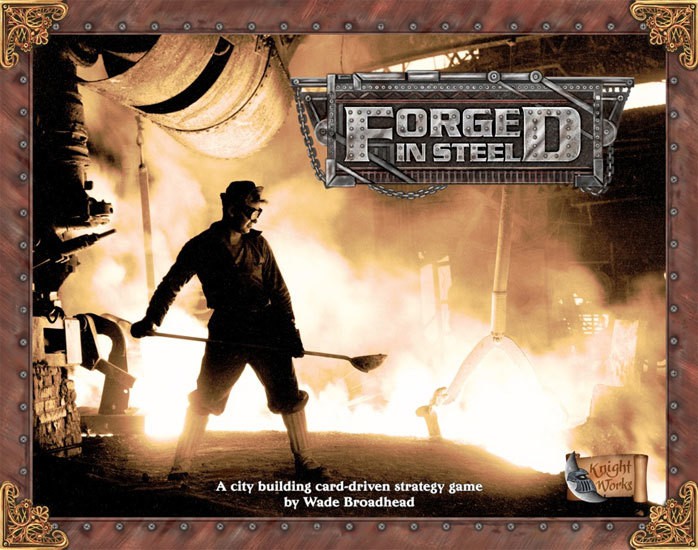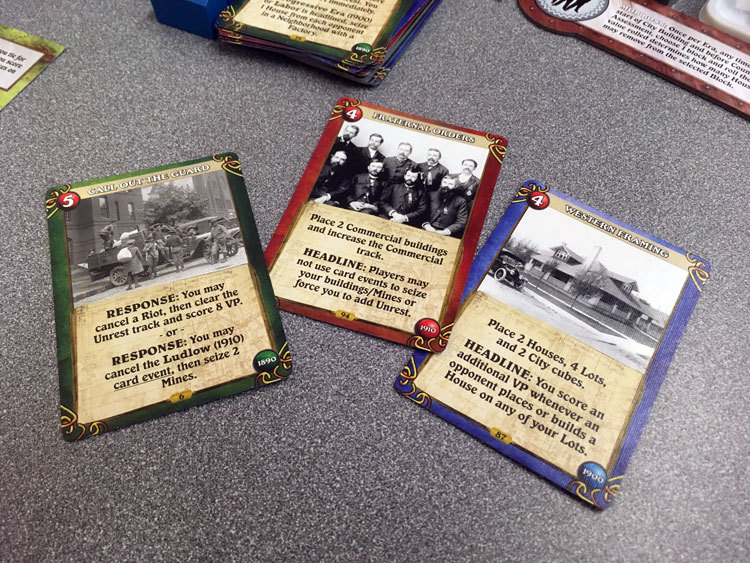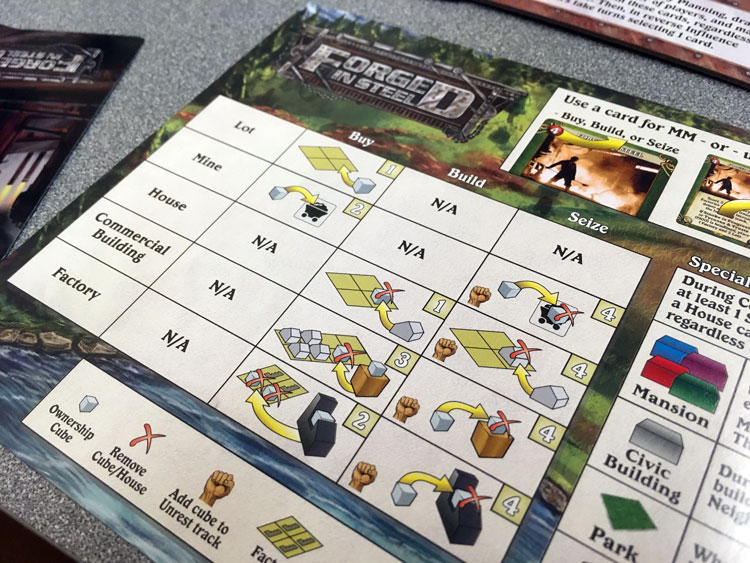 Americans sometimes look across the “pond” and see Europe as a fanciful world of culture, refinement, near-fantasy and elitism. As Eurogames become more and more common in the United States, the historical themes that inhabit these games form a pastiche of cities steeped in mythic-Euro culture and an Old World feel.
Americans sometimes look across the “pond” and see Europe as a fanciful world of culture, refinement, near-fantasy and elitism. As Eurogames become more and more common in the United States, the historical themes that inhabit these games form a pastiche of cities steeped in mythic-Euro culture and an Old World feel.
Americans often don’t look at the birth of their own towns and cities the same way. The West’s beginnings were rough and the advent of industrialism bred cities of steel and hard times. It is rare indeed to find a game that tackles this theme. What’s rarer is to find a game where this theme matters and engages players. Wade Broadhead and publisher Knight Works have taken a big risk to see if that can add a new voice to the scant landscape.
Forged in Steel is a card driven, city building game for 2 – 4 players which takes about 30 minutes per player. To learn the game, a game with two players is great. However, to get the most out of the game, four player games are recommended.
Game Overview:
Players occupy the roles of influential businessmen in the city of Pueblo, Colorado at the beginnings of the burgeoning town. Players will place various buildings in the city and try to expand mining, industry or commercial interests. Building locations and values award points and the player with the most points at the end wins.
Game Components:

The quality of all components is very good, especially the cards, main board and wooden buildings. The factory pieces (large black wood pieces) are especially evocative. All in all, it’s satisfying to handle and place these on the board seeing the city slowly develop.
On a more sour note, the art provides some mixed impressions. The main board art has the style of a lackluster city mural that you might see at a city hall. However, the card art is wonderful with engaging photos from real history providing the visuals. The cards, which represent city events, also occasionally include quotes or comments on the era to help players understand the significance of different events.
Player mats carry the same art as the board, and while a bit drab in iconography, are exceptionally well done in terms of delivering necessary information to players. With a game that can have some complex scoring and action rules, this is especially appreciated.
In regards to the documentation included in the game, again this is hit and miss. The rules are very well written, but the layout hampers reading. The included examples for various rules make sense, but the organization of the text to pages makes some things hard to find when visually scanning.
This is in contrast to the included companion guide which includes the same layout, but since this is meant more for casual reading, the layout works to help history-buffs learn about Pueblo, Colorado and the various cards.
How to Play:
Each game of Forged in Steel is comprised of three rounds of play representing the three decades of the city’s birth, and three decks of cards with events from three decades are included.

After the main board is prepared with tracking markers, play begins with the players receiving cards from the first deck. There is a card selection process in each round by which players are dealt new cards, adding to cards set aside from an earlier rounds. The cards also have points in the upper left corner which represent action points (called Municipal Muscle). If the player chooses not to play the card for the main event pictured, they can use the action points to construct or even seize buildings.
After cards are selected, players continue setup by selecting roles. These roles represent the influence of various power groups in the city. Each role grants a special ability during the game round, some of which are more powerful than others at different times in the game. The completion of setup has players adding two houses near city hall and a single mansion to the board in any city neighborhood.
The game moves through four main phases which allow for the main plays of the game. These phases are City Building, Immigration, County Assessment (scoring) and Elections.
City Building
During this phase, players simultaneously select a single card and then reveal it. The player whose card has the lowest Municipal Muscle takes their turn. If the player chooses to use the card for the event, they complete the required moves such as place buildings or claiming ownership of lots (single spaces). If the player uses the action points, the player can purchase various lots or construct buildings on any owned lot. Some lots are owned by the city which grants the mayor victory points. If a player buys a mine, they receive victory points immediately as well. Other placements such as houses, factories, and commercial buildings have their own placement rules and generate points during scoring.
Immigration

Part of the necessity of claiming ownership of lots is for the immigration phase. Additional new houses are constructed based on the number of industry and commerce buildings on the board. If players cannot place all the required buildings, they add tokens to the unrest track which can cause a riot if it goes too high. In addition, as players place houses, they’re aiming to score additional points for their own houses.
County Assessment & Elections
These phases have players scoring points for their building placements and then determining player order by virtue of who controls which neighborhood. Each neighborhood on the board has a short prosperity track which indicates whether houses and mansions are worth one or two points.
Each economic sector (mining, industry and commerce) also has a track which indicates the various points to be gained for those buildings. The tracks reward commerce and industry on a higher scale, but players can also make points early if they rush for mines and are able to improve that track.
A short cleanup phase ends the round and then the process repeats twice more. The city planner role helps deal out a new hand of cards with the power to choose first from a small draft of cards.

Game Experience:
If an overall effect occurs from playing Forged in Steel, it’s that play is either highly aggressive, engaging and interactive – or it is not. Many city building games strive to aim above multiplayer solitaire modes of play and Forged in Steel succeeds to the degree that players inhabit that aggressive play. The game has all the tools of a great experience, but it hinges highly on player count and the personalities and strategies of the players.
The basic play of this card-driven-game (CDG, a term which describes games such as Twilight Struggle and Terraforming Mars) is extremely engaging and thematically visceral. The card events reveal actions which directly relate to their historical implications. On top of this, selecting just the right cards and knowing when to use a card for action points is always tense. The feeling is equivalent to a carpenter hiring players to build a bird house and then dumping a random set of tools and supplies for players to use.

With this comes the wonderful intrigue of building placement strategy. Each building has it’s own nature and access to points. Savvy players can quickly pick up on the ideal placement for mansions and houses while minimizing the negative effect of factories. Civic buildings, parks and even hospitals also have significance. The main weakness here is hospitals, which may or may not see play depending on the strategies of players. Players can succeed by branching out or focusing on certain buildings.
Because much of the game is driven by the player strategies, which cards they get, and the nature of play, sometimes disappointment can occur if a strategy suddenly becomes non-viable. The game depends highly on tactics due to the unsure receipt of cards that aid strategies. Players can only rely on a strategy to the degree they get the right combination of cards, but successful players are always able to make do with what card options they’re given.
This could result in one player having an easier game than another player because they just happened to receive the right cards. Given that the card events deliver more efficient building placement than the action points, players are “encouraged” to follow the cards as much as possible. This may give players the feeling they are forced to take certain actions based on what they’re given.
Forged in Steel can also make players feel disadvantaged by the roles available. The roles may or may not have a lot of effect on any individual game. At all player counts, the roles are unevenly distributed with three player games having arguably the worst distribution (1st player – two roles, 2nd player – two roles, 3rd player – one role).

This mechanism invites questioning from players who may have received punishment from the Mob Boss. It would have been more fair (and seems just as playable) to have each player only select one role. The roles can have a big impact if a player’s strategy hinges on certain building placement or certain situations. Otherwise, they grant a modicum of victory point opportunities throughout the game.
The other noticeable caveat with Forged in Steel is the presence or lack of player interaction. At lower player counts, players can easily disengage from one another and simply pursue their own building strategies. The board offers enough space that competition for location rarely comes into play.
With four players, the game supremely shines with a noticeable need to strike out for victory point opportunities. As such, this reviewer feels that the game really only can be played to full effect at four and maybe three players. It very much depends on the personalities and competitiveness of the players. The game adapts for different player counts only in the number of cards in the deck, which seems woefully inadequate to preserve the game tension.
The one thing that always comes across well is the theme. As strange as it is to say, the theme is exceptional in this game. Telling the theme to players can have them rolling eyes with memories of middle school museum trips. However, there are very few games which delve into this era of American history and fewer still that address the industrialization of smaller cities. Knight Works receives high marks for taking on such a challenge and succeeding with a game with lots of strategy and options.
Final Thoughts:
Forged in Steel is a unique game. Scanning the vast landscape of board games, only a handful come to mind that explore the economic landscape of nascent American cities. Like Copper Country and Carson City, the game throws a curve with theme but then lands it home with really engaging card play. If the art and balance of play at different play counts were better, Forged in Steel would receive louder applause. As it stands, it will likely stay on the shelf until the right group of four is found.
If you’d like to get a copy of Forged in Steel, you can pick it up for about $50.
Final Score: 3.5 Stars – An extremely engaging game is a great pick for gamers looking for a city building game, but needs 4 players to really shine.
 Hits:
Hits:
• Many tactical options in gameplay
• High interaction potential
• Engagement with theme
• Intricate scoring and decisions
Misses:
• Scalability of play missing
• Main board art is lackluster
• Strategic choices limited by randomness























I can’t believe the amount of detail you went into in this review. If I’d had any questions about the game, you sure would have answered them! I’m not much into building-type board games, but your breakdown description did manage to get me interested. Thanks for a great review!
Thanks Gary. Very nice of you to say so. I take my reviews very seriously and I HOPE I give a clear picture of the game.